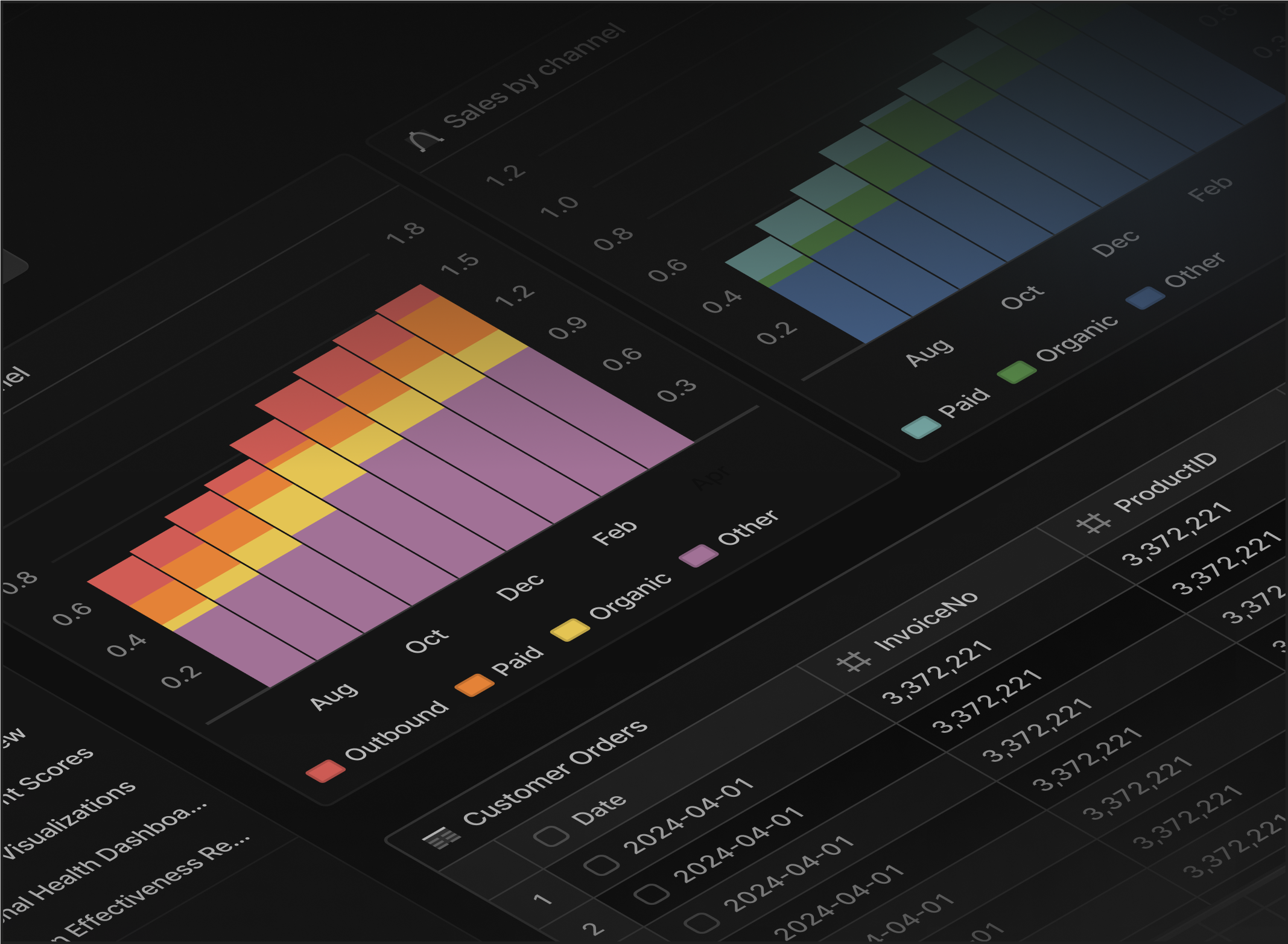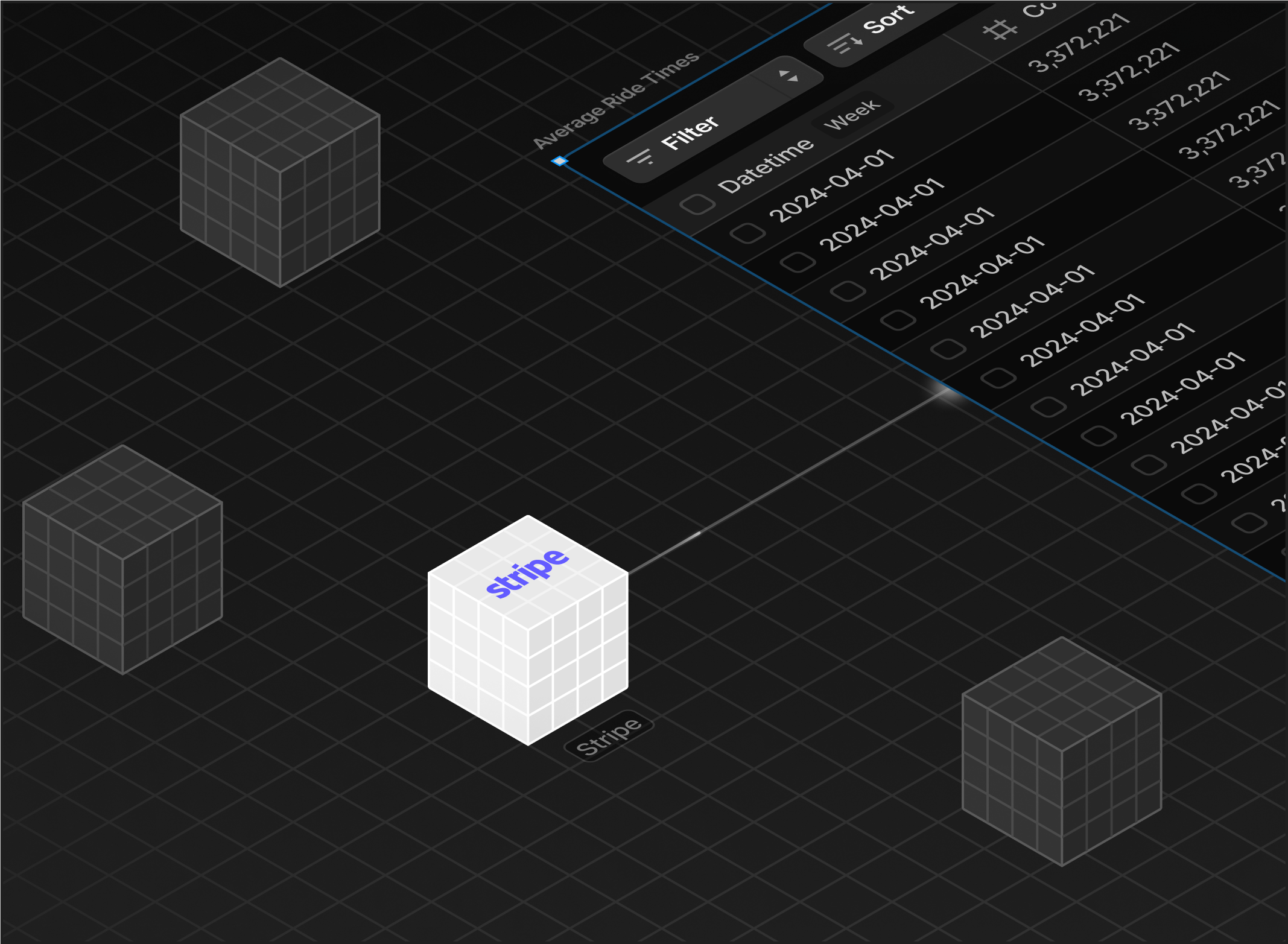Connector Database / Quickbooks
Analyze your Quickbooks data with AI
Build interactive dashboards, generate automated reports, and unlock business intelligence insights from your Quickbooks data with AI-powered assistant.
_

Start with a question
Generate automated reports and business intelligence insights from your Quickbooks data—as fast as you can ask them.


Build dashboards and data visualizations
Transform your conversation into dynamic data visualizations on an intuitive data canvas.
Integrate all your data
Unify your Quickbooks data with DuckDB-powered data warehouse including Zendesk, Salesforce, PostgreSQL and Attio.

Available Quickbooks Data
Connects to QuickBooks Online to extract core accounting objects (accounts, customers, vendors, invoices, bills, items, journal entries, payments, taxes, terms, departments, attachments, etc.) and financial reports (Profit & Loss, Balance Sheet, Cash Flow, General Ledger, A/R Aging, Transaction List). This enables analysis of revenue and expense trends, cash flow forecasting, A/R and A/P aging, general ledger reconciliation, and building finance dashboards.
Income Statement (Profit & Loss)
Shows revenue and expenses over a period, enabling analysis of growth, gross/operating margins, and time-based trends by account, item, department, or class.
Balance Sheet
Summarizes assets, liabilities, and equity at a point in time; supports liquidity ratios, working capital, and leverage analysis.
Cash Flow
Tracks cash inflows and outflows to show how operations, investing, and financing impact cash; supports burn rate and cash forecasting by day or month.
General Ledger
Complete journal of debits and credits with running balances; used for reconciliation, audit trails, and account-level variance analysis.
Customers & Receivables
Captures customers, invoices, payments, and outstanding balances; enables A/R aging, DSO, collections performance, and customer cohort revenue analysis.
Vendors & Payables
Covers vendors, bills, purchases, and credits; supports AP tracking, payment timing, and spend analysis by vendor and expense category.
Sales (Invoices & Sales Receipts)
Represents booked and recognized sales activity; supports revenue trends, cash vs accrual views, and pipeline-to-cash performance.
Items (Products/Services)
Catalog of products and services used on transactions; enables revenue, COGS, and profitability analysis by item and product mix.
Accounts (Chart of Accounts)
Master list of financial accounts that structure reporting; supports mapping, rollups, and consistency across statements and the general ledger.
Budgets
Planned financial targets by account and period; enables budget vs actuals, variance analysis, and performance tracking.
Tracking Categories (Departments & Classes)
Organizational dimensions for slicing financials; supports departmental P&L, class/project profitability, and allocation reporting.
Taxes
Tax rates and codes applied to sales and purchases; supports tax liability calculations and compliance reporting.
Authentication Required
Connects securely to your QuickBooks Online company using OAuth 2.0 with your app’s Client ID/Secret and a Refresh Token
Getting started with
Quickbooks Analytics & Business Intelligence
Connect your Quickbooks data
Connect to Quickbooks once and automatically sync data to your centralized data warehouse for real-time reporting and analytics.
Build business intelligence models
Create automated reports, dashboards, and data visualizations with customizable business logic and AI-powered insights for consistent analytics across your organization.
Generate reports and insights
Create interactive dashboards, automated reports, and data visualizations with AI-powered business intelligence. Share live analytics and scheduled reporting with your team.
Want to see how easy it is to get started?
Quickbooks usersDefinite
People love Definite because it lets you focus on what matters. Setting up your own data infrastructure doesn't make your beer taste better. Skip the tedium and start at analytics.
I was leading the efforts of setting up a business intelligence function. I was surprised how complex this all was to do even today. It's something that every tech company would need at some point but it hasn't been simplified. You need a whole team focused on building a data warehouse, setting up the right pipelines, and then integrating a BI tool on top.Definite wasn't only the answer to this problem, it tackled the next problem I knew I'd have as soon as the BI tool was ready — how do we get non-technical teams and people to learn and utilise such a tool.
Our analytics before Definite consisted of dozens of Excel sheets that took hours to update. Manual updates led to errors. Everyone questioned the accuracy of the numbers. Many people just stopped looking at the reports.After Definite, everything ran like clockwork.We immediately saved thousands of dollars per month in the time spent updating reports and have built strategies (e.g. improved ROI on ad spend, inventory management, etc.) on the data that will yield millions to our bottom line.
Have questions?
Find answers.
Definite has everything you need to deploy analytics within your company.
Data doesn't need to be so hard
Get the new standard in analytics. Sign up below or get in touch and we'll set you up in under 30 minutes.